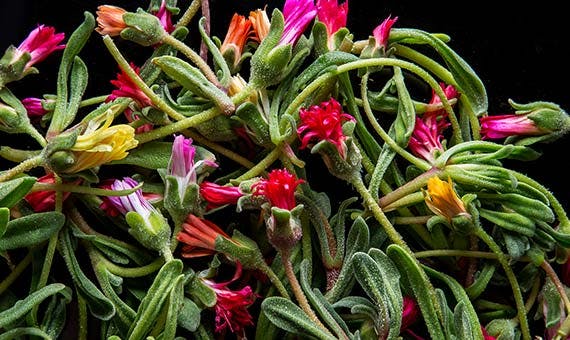What Are Edible Flowers? Plus Cooking Ideas And Tips
Put the petal to the metal with our edible flower primer
April is Homegrown Month at Tasting Table.
"It's like you're sneaking the flavor in," Matthew Johnson from Marx Foods tells us. "They're a lot more delicate than the actual vegetable, but I think it's safe to say that garlic flowers look a lot neater than minced garlic."
We're talking with Johnson, food writer for Marx Foods, and the Seattle-based exotic ingredients purveyor's founder, Justin Marx, about edible flowers and just what to do with them these days if you're not David Kinch or a wedding cake decorator.
Apparently, we should be using them for a lot more than just garnishing.
So in order to put the petal to the metal, we came up with this edible flower primer, which includes everything from the basic buds you can find in your garden to those blossoming on your farmers' market greens, as well as unusual finds to look out for, like buzzing Sichuan buttons.
 Ice plant flowers
Ice plant flowers
Ice plant flowers: Succulents on your desk, succulents on your windowsill and now—succulents on your salad. The fingerlike limbs of this invasive South African species have the same crunchy, fibrous quality as its office-friendly cousin but a distinctly sour flavor and slightly slimy, fleshy insides, hence the nickname "sour fig." The flowers are great as a thickener for sweet syrups, but you'll probably want to go for the sweeter Easter-colored flowers, typically cooked down into sweet jams in South Africa. We're thinking they would be a stellar textural counterpart to fatty fish or cold soups.
Chive blossoms: Notice some purple bulbs dangling off your bunch of chives? Don't throw them away! These tiny buds pack a lot of a flavor reminiscent of their big brothers. "The primary benefit to using the flowers instead of their vegetable counterparts is the look," Johnson notes. "Choosing the right ones lets you bring some of the flavor of the vegetable, or sometimes a lot of flavor, like chive blossoms." We're into pretty. (Have you not seen our Instagram?!) Make compound butter more aesthetically pleasing and delicately oniony by smashing the little purple petals into it or try sprinkling them over gnocchi and scrambled eggs.
 Sichuan buttons
Sichuan buttons
Sichuan buttons: Even if you haven't heard of this yellow Brazilian fuzz ball notorious for its Pop Rocks-like, mouth-numbing sensation, you've definitely had it if you've ever gargled mouthwash, chewed gum or sucked on a cough drop. Spilanthol, a fatty acid found in the plant, is the chemical culprit behind that tingling taste and its saliva production-provoking qualities. The guys at Marx Foods have harnessed its Sichuan peppercorn-esque power in cocktails by infusing it into herbal spirits like gin.
Pansies: Don't be a, well, you know, when it comes to cooking these hardy wildflowers, which sprout up like weeds in cooler months. They have a powerful yet refreshing wintergreen-like flavor with some lemony notes, key features that led to one fantastic Marx Foods creation. "One of the coolest things we've ever done is make sorbet out of pansies," Johnson explains. "Gorgeous and delicious." Aside from churning out the most intense mint chip ever, these maroon, purple and yellow guys can easily be candied (aka shellacked with sugar water).
 Dulce buttons and leaves
Dulce buttons and leaves
Dulce buttons and leaves: Known as tzonpelic xihuitl and used to treat sore throats and coughs back in ancient Aztec days, this leafy herb with dandelion-like bulbs is 500 to 1,500 times sweeter than granulated sugar (stevia comes in about 200 to 300 times sweeter), thanks to its heaping amounts of hernandulcin. However, there are some nuances to this sugar bomb—traces of mint, anise and thyme lend a more herbal mustiness. And one bud or leaf goes a long way: Crumble it atop fresh fruit salads and meaty foie gras tartines or swap in for simple syrup to make potent mint juleps at home.
Nasturtiums: Known as Indian cress, these brightly hued blossoms descend from the same family as peppery watercress, so that's why you'll detect the same mildly bitter taste (though the petals are sweeter than the flower's dark veiny leaves). Yes, they're pretty as cake decorations or salad garnishes, but you can also stuff them Italian style like squash blossoms with ricotta, fold them into creamy crab or potato salads, or swap them in for arugula atop your next pizza.
 Fennel flowers
Fennel flowers
Fennel flowers: First it was the frilly fronds, then the pollen and now the hot fennel byproduct of the moment is the vegetable's tiny golden flowers. They've got sweeter notes of anise compared to the actual vegetable and are less vegetal and cool tasting. That, in addition to their tiny stature, makes them perfect for dropping in sugar for a punchy licorice-like sweetener to amp up your sugar cookies. They also stand up to big gamey meats, like braised wild boar and lamb roasts.
Pineapple buds: So new that they're not even available at Marx Foods yet (stay tuned though), these adorable green bulbs are grown exclusively by Fresh Origins in San Marcos, California, and they taste and smell just like the prickly, honeyed fruit. A hot bath in simple syrup is an easy way to go, but we think they would be fascinating as a sub for chunks of the fruit in tacos al pastor or studded atop these grilled short ribs.
